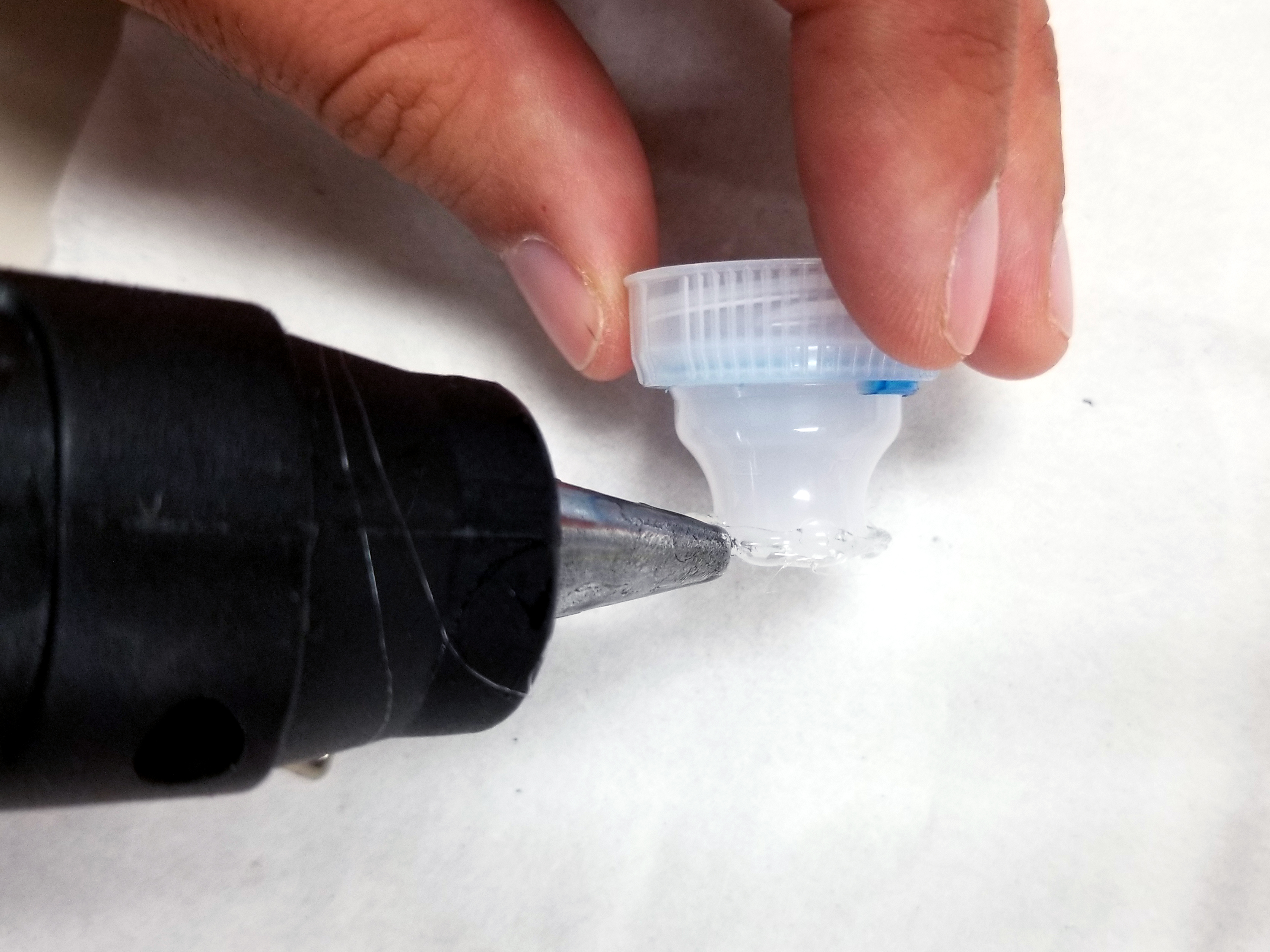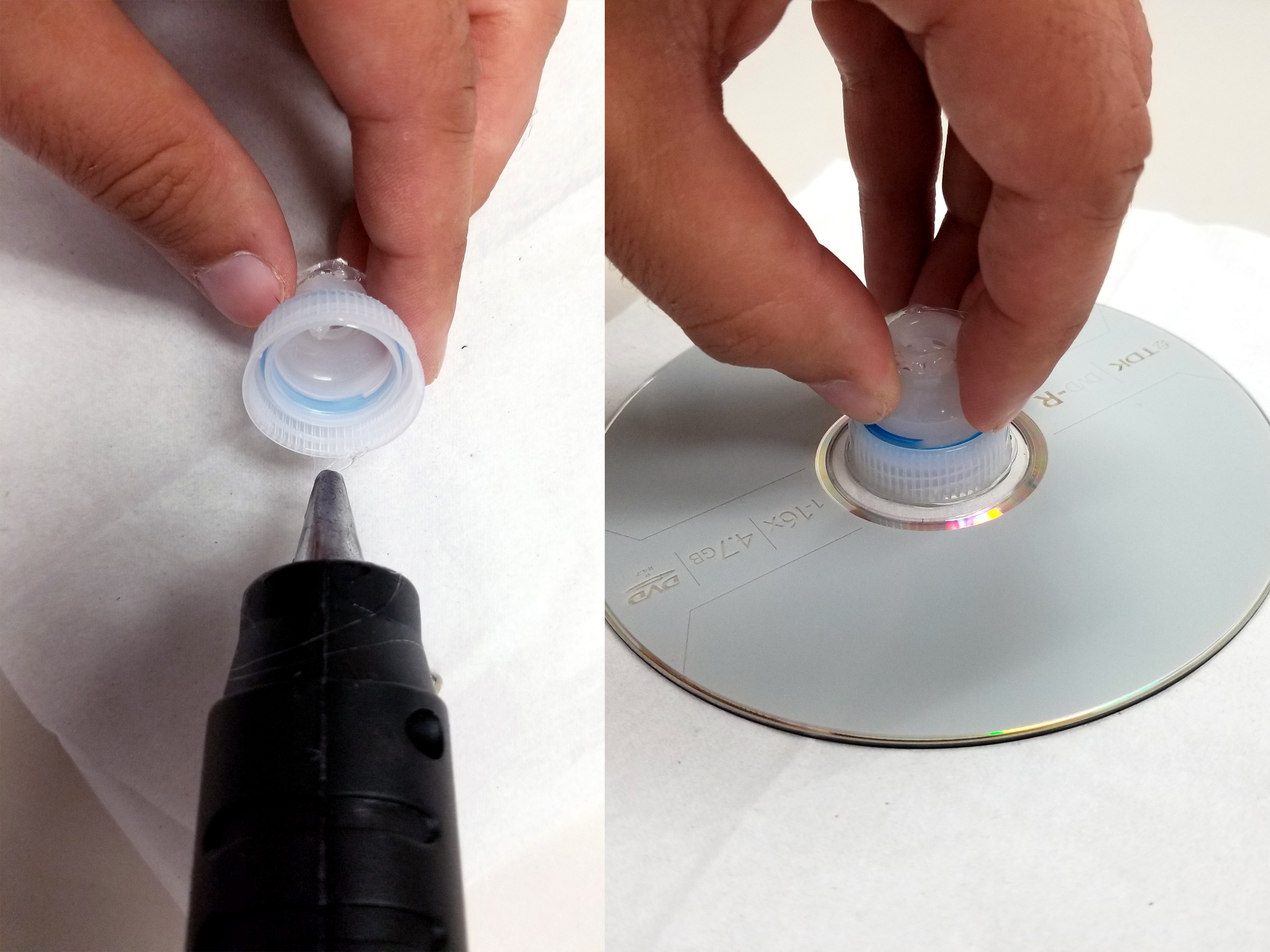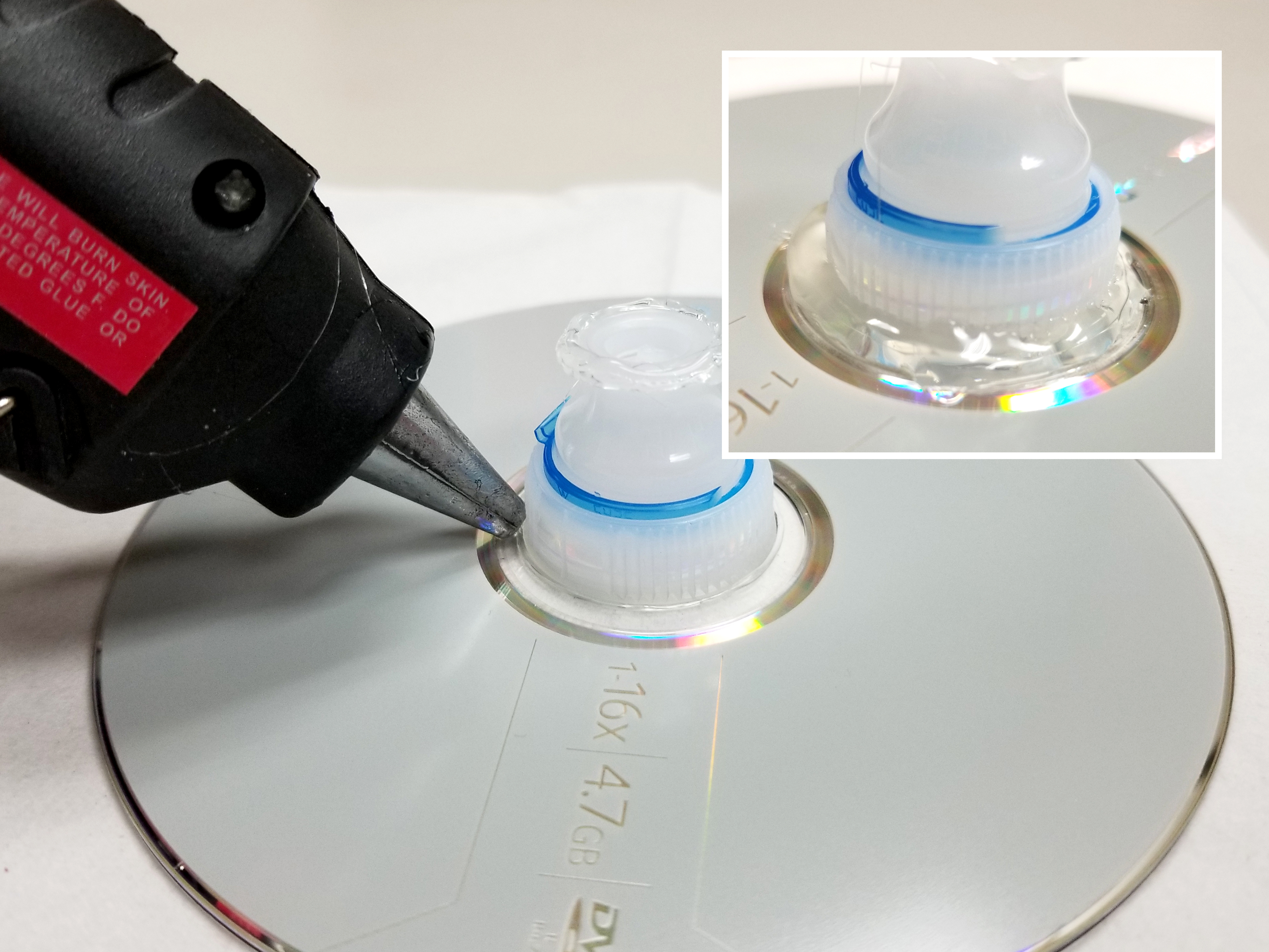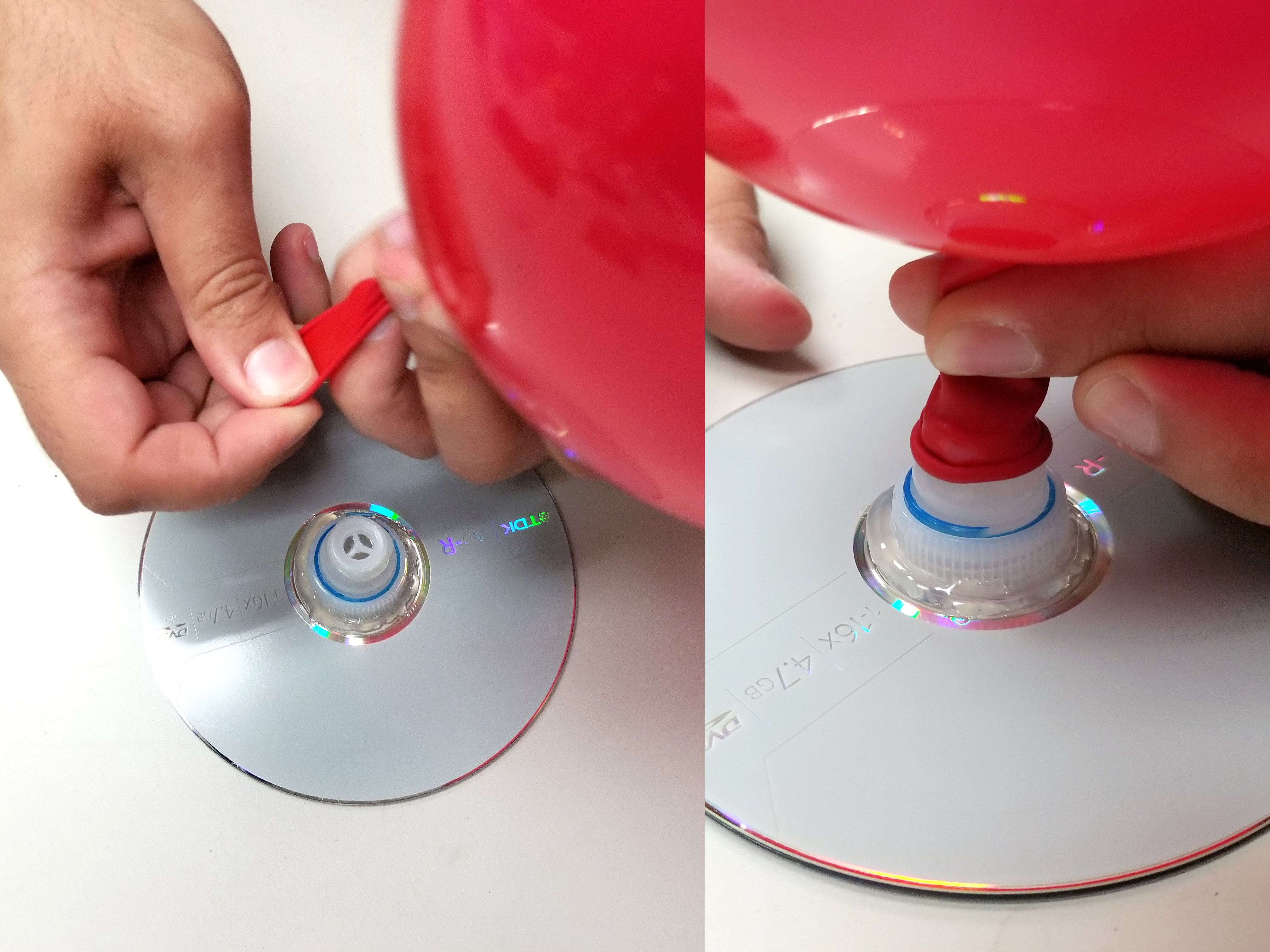Hovering on a Cushion of Air
Overview Hovering on a Cushion of Air
Students will construct CD hovercraft and apply Newton's laws of motion to make them work. They will also investigate how hovercraft reduce friction; learn how the technology is used in training astronauts for space missions; and design their own hovercraft competitions.
Materials
Management
- For younger students, cut the flip-top from the bottle top in advance.
- Set up a glue station with one or two glue guns. Be sure to use low-temperature glue guns. The heat from high-temperature guns may warp the CD. Having a dish of cold water near the glue station is a good safety step. If students get hot glue on their fingers, immersing the fingers in cold water will immediately “freeze” the glue and minimize any discomfort. If preferred, the teacher or a teacher’s aide can operate the glue gun. Eye protection is recommended when working with glue guns.
- If you have any student with a latex allergy, wash the balloons before using. Have allergic students wear non-latex plastic gloves and inflate the balloons with a balloon pump (or form small teams and give the balloon handling part of the activity to non-allergic students).
Background
What’s a Hovercraft?
A hovercraft surface vehicle at NASA's Ames Research Center. Image credit: NASA | + Expand image
Hovercraft are vehicles used for carrying people and heavy objects over water and rough surfaces. Powerful fans, like airplane propellers, blow air downward. The air blast is caught by a skirt that lifts the craft above the surface before the air escapes to the sides under the lower edges of the skirt. This reduces friction with whatever surface over which the craft is hovering and enables it to be easily propelled by action/reaction with other fans mounted horizontally.
If you have mixed feelings about friction, it’s easy to understand. Friction is the force that resists motion when two objects are in contact with each other. It’s both good and bad. Take cars, for example. Forget to check the oil, and friction can ruin a car engine. However, without friction a car couldn’t move. Tires are made from rubber, which produces friction with the road surface. When the wheels turn, friction enables the wheels to exert a force on the road to propel the car.
Reducing friction is important in many sports. Ice hockey depends upon the puck being able to slide across ice. Curling, a sport similar to shuffleboard but with heavy stones instead of pucks, also needs ice to slide across. Team members actually sweep the ice in front of moving stones to help reduce friction and guide the stones to the target. Bobsleds and luge sleds run down ice-covered chutes to achieve breakneck speeds. The chutes twist and turn. Runner blades on the sleds reduce downhill friction to attain high speeds while increasing sideways friction to help steer the turns.
Reducing friction makes it easier to start objects moving. Isaac Newton’s first law of motion explains why. The law states that objects remain still unless acted upon by unbalanced forces. In other words, if forces on an object are unbalanced, the object moves. What then is an unbalanced force?
To understand unbalanced forces, imagine what would happen if you and a friend were to push on each other with equal force. Neither of you would move because the forces are balanced. However, if one of you pushes harder than the other, movement takes place because now the forces are unbalanced. An ice hockey puck, for example, is resting on the ice. The ice surface is very slick, but it still has a small amount of friction. When a player smacks the puck, the puck shoots across the rink. The force exerted on the puck by the stick is far greater than the force of friction trying to hold the puck where it is. Consequently, the forces are unbalanced, and the puck shoots away.
Newton’s first law of motion also explains that an object in motion will travel in a straight line at a constant speed unless an opposing unbalanced force slows or stops it. In ice hockey, the goalie will try to exert an unbalanced force by blocking the puck. If the goalie misses, the goal net will exert the unbalanced force and stop the puck - score 1!
Understanding Newton’s first law of motion is important for astronauts training for future space missions on the International Space Station (ISS). When in space, they will have to move objects and themselves from place to place. To do that, they need to exert unbalanced forces. But being in space is something like being on an ice rink on Earth. Try taking a quick step on an ice rink without wearing ice skates. With little friction, you are likely to end up on your backside!
In space, friction is greatly reduced because of the microgravity environment. It feels like gravity has gone away. Of course, gravity is still there because gravity holds the ISS in orbit. But orbiting Earth is like a continuous fall where the spacecraft and everything inside falls together. The type of friction caused by objects resting on each other is gone. To move, astronauts have to push (exert an unbalanced force) on something, and to stop themselves, they have to push on something else.
How can astronauts practice for the microgravity environment on the ISS? NASA uses many different simulators to train astronauts. One simulator is something like a large air hockey table. It is called the Precision Air Bearing Platform (PABP) and is located at NASA Johnson Space Center in Houston, Texas. The PABP uses moving air to produce a powerful lifting force very much the way hovercraft work. High-pressure air rushes out of three small pad-like bearings and lifts the pads, and a platform mounted above them, a fraction of a centimeter from the floor. No longer resting directly on the floor, the device, with the astronaut on top, is virtually frictionless.
There is one more important feature of the PABP. In order to move across the floor, the astronaut has to push on something. Additional air is fed to small nozzles around the astronaut. The astronaut uses a hand control to release the jets of air in different directions to create a push. How much of a push the astronaut gets determines how fast he or she slides across the PABP floor. This is explained by Newton’s second law of motion. The force of the air jets is equal to how much air shoots from the jets times how fast the air accelerates. Newton’s second law of motion is really an equation.
Force = mass times acceleration (F=m x a)
With the control jet, the more air shot from the jet and the faster it shoots out, the greater the force produced and the more the astronaut moves.
There is one more law of motion. This is Newton’s third law of motion. It is also called the action/reaction law. When a force is exerted (action), an opposite and equal force (reaction) is created. You can see this with rockets. Burning rocket propellants produces gas that shoots out of the engine. The rocket moves in the opposite direction. If you happen to be riding a PABP like the one at the NASA Johnson Space Center, you get to experience action/reaction first-hand. The PABP greatly reduces friction and an air jet (action) propels you across the platform (reaction). Unless you exert a new action force in the opposite direction, you will smack into the wall surrounding the PABP.
Analyze any sport or the movements of astronauts in microgravity, and you will see all three of Isaac Newton’s laws of motion at work.
Procedures
Steps 1 and 2 | + Expand image
Step 3 | + Expand image
Step 4 | + Expand image
Step 5 | + Expand image
Step 9 | + Expand image
Hovercraft in action | + Expand image
Assembling the hovercraft
- Use scissors to cut the flip top off the bottle top.
- Use sandpaper to roughen the smooth plastic along the circumference of the upper opening of the bottle top.
- Squeeze a bead of hot glue along the circumference of the upper opening of the bottle top. Allow to dry.
- Squeeze a bead of hot glue along the bottom edge of the bottle top and immediately press the freshly-glued end to the center of the CD (label side up). The bottle top will surround the hole in the center of the CD.
- Squeeze a bead of hot glue around the bottle top where it meets the CD to ensure a good seal between the two.
- When the glue has cooled and hardened (in about 1-2 minutes), check for any gaps between the CD and bottle top. If there are any, squeeze some glue in to fill the gaps.
- Stretch the latex balloon a couple of times to relax it for inflating.
- Inflate the balloon and twist the nozzle end to prevent air from escaping.
- While holding the inflated balloon by the twisted part, stretch the balloon nozzle over the bead of hardened glue at the top of the bottle top.
Running the hovercraft
- Place the craft on a smooth, level surface such as a tabletop. Release the balloon. It will untwist and start blowing air downward through the small hole in the center. The thin cushion of air will lift the CD and eliminate friction with the tabletop.
- Have students try pushing the hovercraft across a tabletop with the balloon inflated and again with it uninflated. Compare the craft’s movement in the two runs.
- Allow students to experiment with limiting the rate of the air flow by attaching a paper dot sticker to the underside of the CD where air flows through. Students will need to poke a hole in the sticker to allow air flow. They will then determine the optimum size of the hole in the paper dot. The hole can be enlarged by pushing the point of a pencil into it. The hole size will determine how fast the air runs out. Provide more dots for students to try.
- Have students record their data on the Hovercraft Challenge student pages.
Discussion
- What causes the hovercraft to become frictionless? Explain.
Air from the balloon escapes beneath the hovercraft. It forms a thin cushion that lifts the craft a few millimeters above the table. Without direct contact with the tabletop, friction is greatly reduced. - What happens to the hovercraft’s movement when the balloon runs out of air? Why?
When the balloon runs out of air, the lifting cushion stops. The full surface of the CD bottom contacts the tabletop, friction is greatly increased, and the hovercraft stops. - How do different surfaces affect the hovercraft?
Smooth surfaces permit a uniform cushion of air to lift the craft. Rough surfaces allow air to escape more in some directions than others and the craft is no longer level. Parts of the CD touch the surface and cause drag. - How does the size of the paper dot hole affect the hovercraft?
The hole controls the flow of air from the balloon. If the paper is removed, the hole is very large and the air escapes quickly. A tiny hole greatly slows the flow of air and may not provide enough lifting force. Through experimentation, the best hole size is _______ (student answer). - Explain how Isaac Newton’s laws of motion control the movement of the hovercraft.
- An unbalanced force is needed to lift the craft. Another force is needed to propel the craft along the table.
- The lifting force is determined by how much air is released (its mass) and how fast it accelerates out of the hole.
- The action force of the air released from the balloon creates a reaction force lifting the hovercraft. Pushing on the hovercraft to cause it to move along the tabletop is also an example of action and reaction.
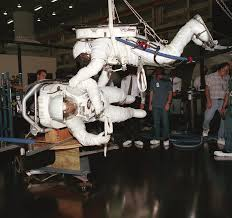
Two astronauts practice space rescue over the Precision Air Bearing Platform (PABP) at the NASA Johnson Space Center. Image credit: NASA | + Expand image
This picture of astronauts at Johnson Space Center illustrates a training technique using air bearing pads on a very smooth floor. Three air bearing pads, similar in size and identical in function to the CD hovercraft, produce great lifting force and nearly eliminate friction. The bearing pads are able to provide much greater lifting force than the CD hovercraft because high-pressure air from compressors is used. When the two astronauts push on each other, they fly apart in a great demonstration of Newton’s laws of motion.
Assessment
Collect and review the Hovercraft Challenge student pages. Use the discussion questions above for a review discussion or have students write short paragraph answers.
Extensions
- Have students try their hovercraft on different surfaces (tabletop, tile floor, carpet, sand, etc.). On which surfaces does the craft work and on which doesn’t it work? Why?
- Investigate the size of the hole in the paper dot.
What hole size works best to keep the craft aloft the longest? (The hole size can be enlarged by pushing a pencil tip into it and spreading the paper.) - Have students investigate how much mass their craft can lift.
Small paper clips have an approximate mass of 2 grams. How many paper clips (or metal washers, pennies, etc.) can their craft hold and still move across a tabletop? - Have students create sporting events for their hovercraft. Some ideas for events might include:
- “Kick” field goals by shooting hovercraft between two water bottles down field.
- Make a net for soccer goals.
- Play hovercraft curling by using balloon pumps or small paper fans students construct to move the hovercraft and have it stop in the bull’s-eye of a target at the other end of a table.
- Hovercraft drag racing (which craft reaches the finishing line first).
- Hovercraft shot put. Go for distance.
- Hovercraft bowling. Aim at lightweight pins made from notebook paper rolled and taped into tubes.
